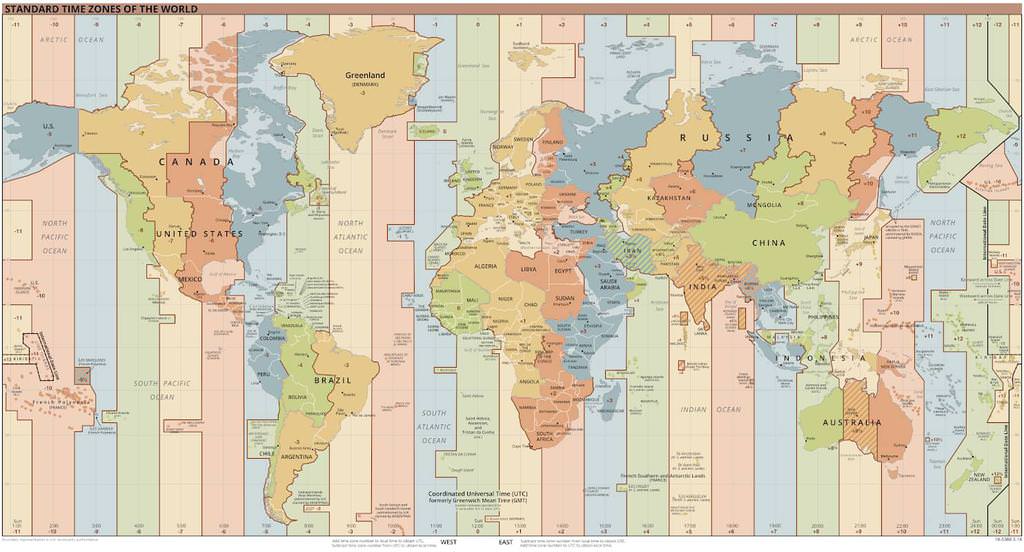Time zones are the result of the Earth's almost spherical shape and its rotation around the Sun. Simply put, when the Earth is exposing its surface to the Sun, it captures light. With the face mentioned above, receiving sunlight, the opposite side is dark instead.
How the sunlight is hitting the Earth's surface can be easily reproduced by placing a tennis ball in front of a lamp: the side close to the lamp is perfectly illuminated, the opposite is in darkness, and those in-between turn from light to shadow, and the other way round. However, "day" and "night" are generic definitions.
According to conventional rules, time is split into 24 hours. Here is the next question: what time is it when standing in an area located in front of the lamp, compared to the same place on the dark side instead? That's where time zones come into play.
Time zone calculation: how do I know what time it is?
Time zones determine the time across the segment hit or not by sunlight. Take an orange, for example. Each slice of that orange has a different time compared to the other ones.
Moving from Italy to the United States is like choosing another "slice." How can we define what time they are? Generally, you can apply a rule as useful as easy to remember when moving from the home time:
-
if you're traveling West, please move the hour hand back;
-
if you're traveling East, please move the hour hand forward.
Just take a map; in those countries placed on your right (east), it is later in the day. Viceversa, in those set on the left (West), it is earlier instead.
It means in most countries, depending on your home time, you can even jump forward to the following day or back to the previous one. For example, if it's 11 pm in Italy on a Saturday evening, it is 7 am in Japan on a Sunday, since they are 8 hours back.
Time zones around the world. Same time, different hours
If there were any doubts about the time difference between one place and another on the planet, it would be enough to do the following experiment. At 9 in the morning, in Rome, you might call a friend living in New York. He most probably won't answer you; if he or she does, be sure he won't be happy to get that call.
When it is 9 am in Rome, it is 3 am on the US's East Coast instead. Taking Rome time as a reference, let's now list the timetables across some of the world's leading cities.
Time zone in Europe

Time zone in the United States
The United States is multiple hours forward. Also, given the territory's extension from the West to the East coast, the US include various timezones:



-
Chicago: 7 hours back
-
Denver: 8 hours back

Time zones in Asia




Time zones in Australia
Time zones in South America
Time zones in Africa
These are the time zones of some of the most relevant cities in the world. You can find a comprehensive overview of the world's timezones here https://time.is/it.
Time zones map
If you're looking for a map including all the universally listed timezones so far, you might find the full chart below pretty useful. You can quickly get how time is changing, from east to West, given the distance traveled from a chosen city or timezone.

Time zones of the world: who decided where to start to define them?
We have seen the map, including time zones from all over the world, using Rome as a common reference point. Each person is free to adopt whatever reference town and own timetable; nonetheless, a reference standard is needed, and here it comes.
Hour zero, else said the starting point, is defined by the meridian passing through the Greenwich Observatory in London. The meridians are imaginary vertical lines representing the so-called "segments" into which planet earth is divided. Initially, this point was called GMT, or "Greenwich Mean Time."
This acronym was later changed to UTC, meaning "Universal Time Coordinated." Every time in the world is, therefore, calculated as a multiple of the UTC. As an example, Rome time is UTC + 1. It means we are one hour later than Greenwich Mean Time.
Time zones: how many are they?
As a result, we might end up thinking planet earth is split into 24. It is not; they are 39 indeed. Across the globe, there are countries whose timezone adds 30 or 45 minutes on top of the reference time we mentioned above (UTC).
It is why, for instance, Nepal's home time is 4 hours and 45 minutes forward than Rome time (i.e., 5 hours and 45 minutes compared to UTC). In Afghanistan, home time is 3 hours and 30 forward than Rome (4 hours and 30 minutes compared to UTC).
If you have read this article carefully, you should have noticed such an off-standard behavior when listing time zones in Asia.
Are there any wristwatches capable of measuring such off-the-standard time zones?
Yes, there are, and they belong to the premium luxury class of products.
The Glashütte Original Senator Cosmopolite is up to the task, for example. It is an extremely refined timepiece offering stand-out engineering that we have extensively described in-depth.
It is extraordinary either from an engineering point of view and for its style, geared towards the most demanding watch connoisseur.
Time zones: one last point
Despite the scientific explanations about time zones, let's always bear in mind that time is a human convention. It is a standard to manage our lives, standardize light to shadow change, and vice versa.
According to economic, political, environmental agreements, the hour standard is subject to change as a social convention. For example, France and Spain share the same time zone as Italy, although not belonging to the same "segment." This standard helps to foster business relationships.
As proof of this concept, let's finally introduce:
-
Solar time: it is naturally marked by the Sun's light, which hits different Earth portions according to Earth's rotation.
-
Daylight Saving Time: It is, again, a convention where we advance our clocks by one hour to save energy. In 2021, daylight saving time will come effective in October, during the night between 27 and 28. At 2.00 in the morning, we should move our timepiece's hands one hour move forward.
(Photo credit: Marco Antinori for Horbiter®)
Tommaso Sabia @Horbiter®




















